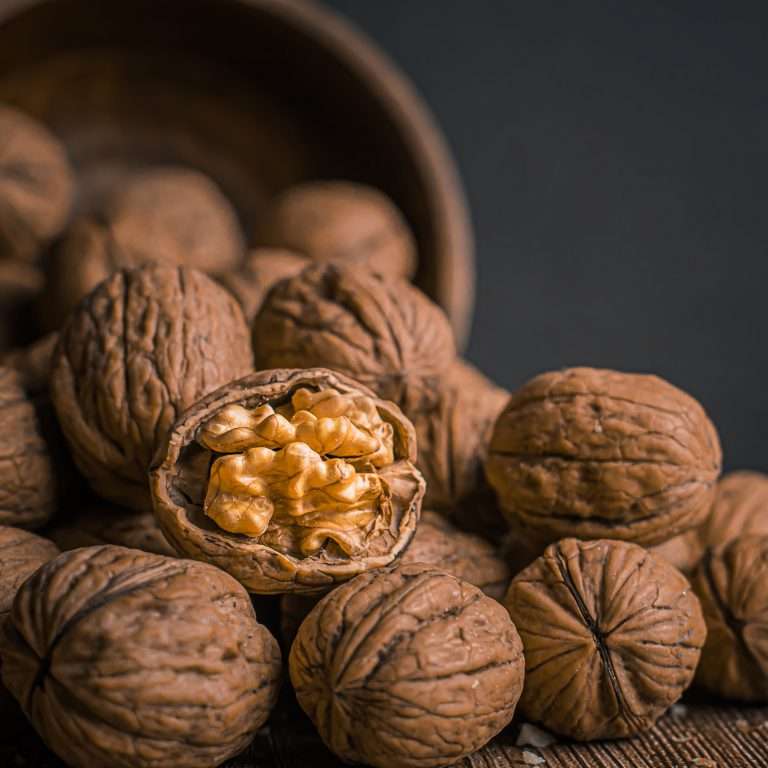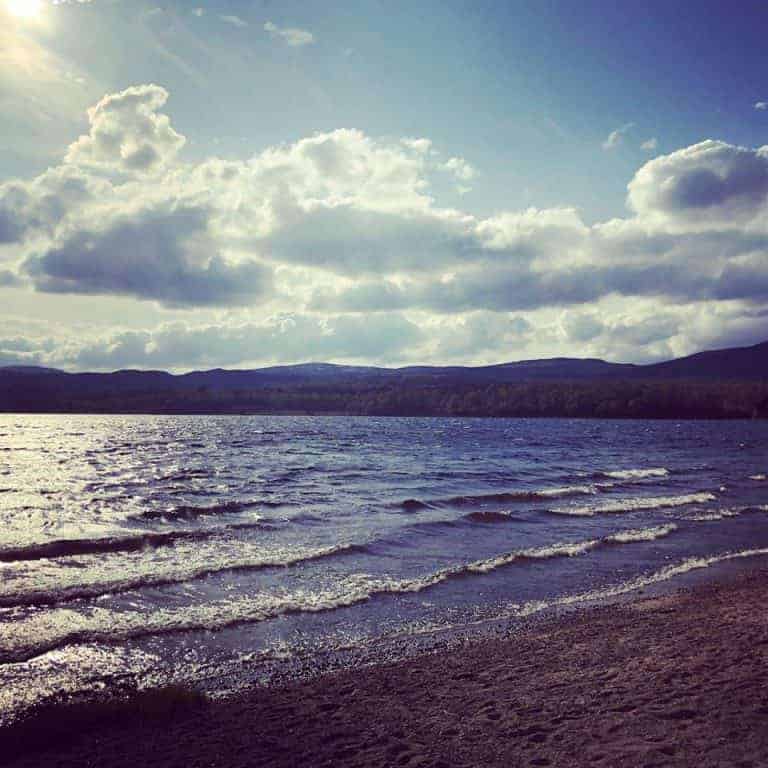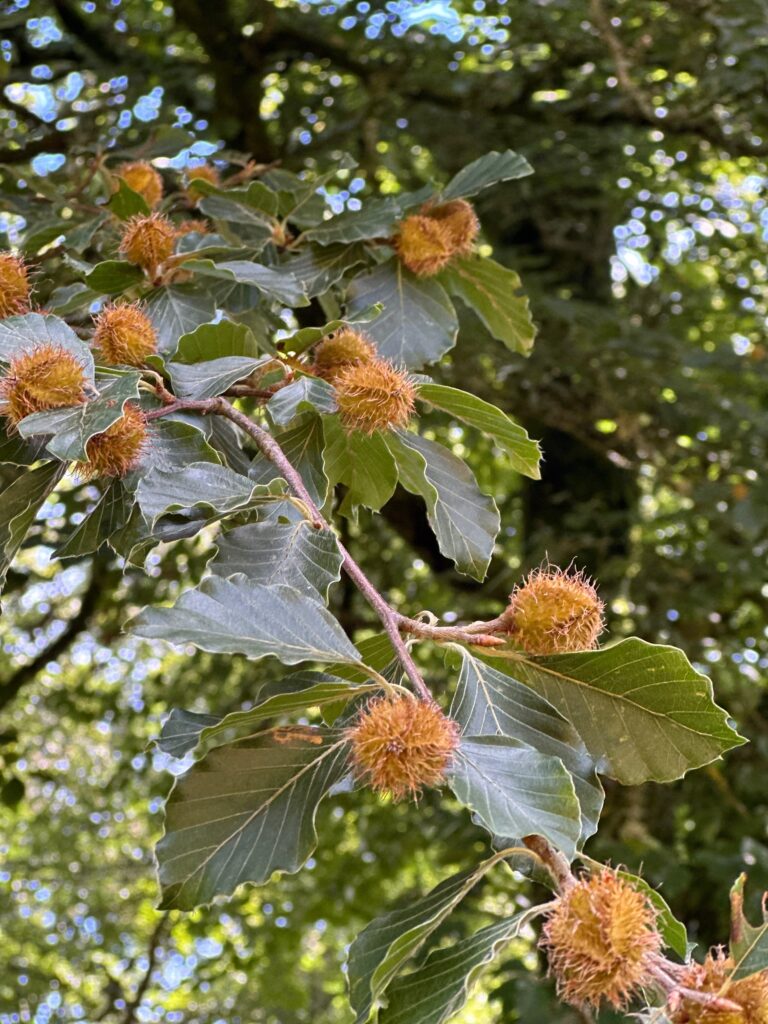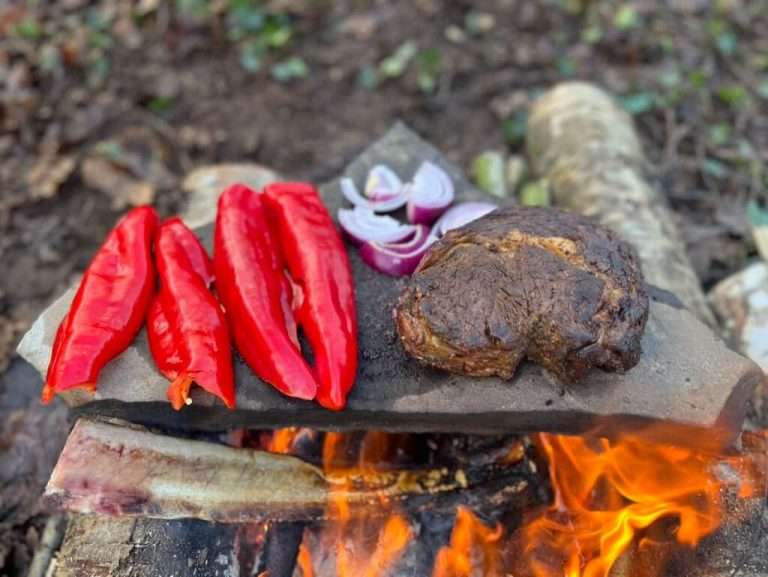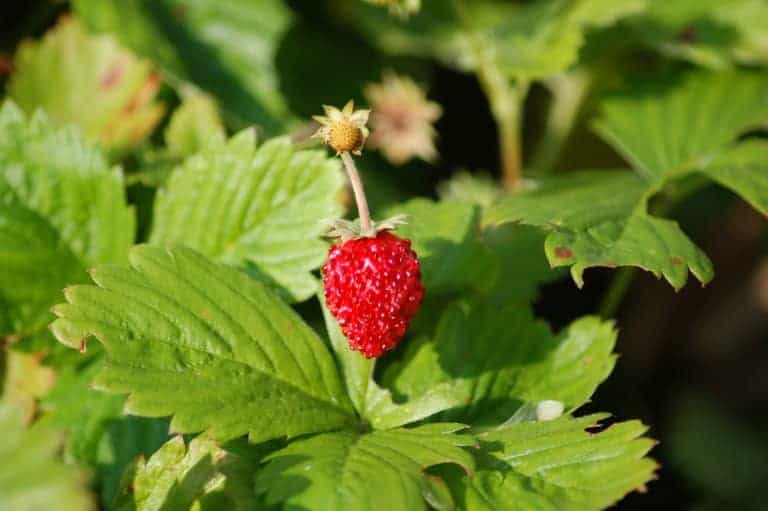Wild Summer Edibles
10 Wild Summer Edibles
As we continue to navigate our way through this strange and crazy year, even more of us are finding solace in the great outdoors and learning the benefits of foraging wild summer edibles.
Whether heading off for adventures, or just exploring the areas near our homes, we will all be noticing the changes in the seasons, maybe even more so this year as we have been forced to slow down and stay closer to home.
Noticing the seasonal changes not only helps connect with nature more but also opens up our eyes for opportunities, the wild summer edible kind!
As spring edibles have passed, now is the time make the most of the summer abundance. Ensuring that you leave enough for the wildlife and have the landowner’s permission, foraging at this time of the year is incredibly rewarding. But be very sure to get your plant identification correct as there are plenty of poisonous plants around too!
Wild Strawberries (Fragaria vesca)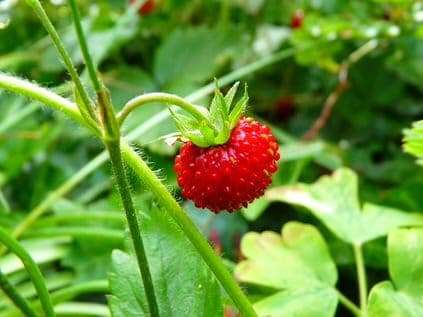
Found in open woodland and scrubland, or on the banks of chalk downlands, these little red fruit are summer treasures.
The plant and fruit look like small versions of the cultivated fruit that we know and enjoy from our gardens, shops and farmers markets. Though it is worth knowing that the wild strawberries aren’t as sweet as the cultivated fruits and are just the size of a 5 pence piece.
The wild strawberry plant produces the same white flower as the cultivated strawberry plants. Once pollinated the small red fruits develop and are then ripe and ready for picking, just ensure that you leave plenty for the wildlife too as these are a great energy source for small ground mammals and birds.
These berries are packed. Full of vitamins and can be enjoyed raw, added to a summer salad or smoothy or cooked into jams and puddings too. I think these are one of the best wild summer edibles around.
Meadowsweet ( Filipendula ulmaria)
The Meadowsweet plant is found across Northern and Southern Europe and is often used in herbal medicine for its health benefits as it is said to treat colds, ease digestive discomfort and to reduce inflammation.
This perennial herb grows in damp meadows, hedgerows and ditches, growing up to 120cm in height. The leaves are dark green on top and greyish underneath, and are deeply veined and toothed along the edges.
Meadowsweet flowers are small and white, growing in clusters. As the name suggests, this sweet smelling flower blooms from June through to September with the white flower clusters up on a long stem. These flowers are often described as having a fuzzy or frothy appearance due to the clusters of longer pollen stamens and are often used in wines, beers and vinegars. Eaten raw the young leaves add extra nutrients to a summer salad or can bee cooked into soups and stews.
Although this plant has many health benefits, make sure you do not get it confused. When foraging at any time of the year plant identification is key. If in doubt, don’t risk it. You must be sure what wild summer edible plant your eating!
Rock Samphire (Crithmum maritimum)
Rock Samphire is best foraged from May to October. This salt tolerant, hardy succulent is found along rocky coastlines, growing on cliffs and in crevices. Care needs to be taken when foraging this nutrient rich perennial herb, so we advise not to harvest from cliffs but to forage from rocky flats, but be aware of incoming tides.
Not leaf like at all, this plant has spraying antler like protrusions that are circular, like multiple stems, not to be confused with the unrelated but similarly named marsh samphire.
The ‘leaves’ of the rock samphire have a strong carroty or herb like taste and make a great nutrient rich addition to a summer salad, as can the flowers that bloom from June to September. From August to October the seed pods can be harvested and pickled making a great substitute for capers.
Rock samphire are high in vitamins and minerals and historically used by sailors to help stave off scurvy due to its high vitamin C content. Though it is worth knowing that this plant is very much like Marmite, due to its distinctive flavour you’ll either love it or hate it!
Wild Cherry (Prunus avian)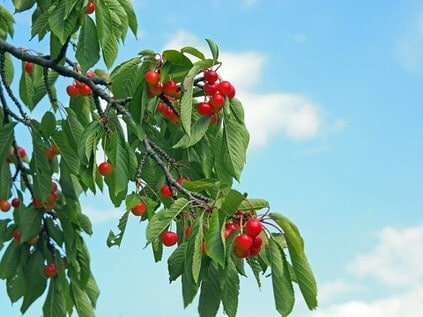
Wild cherry, a popular native tree is often treasured for its abundance of summer berries by humans and wildlife alike. Historically also treasured for its hard wood for building, as well as its source of food, cherry trees can grow up to 30 meters living for up to 60 years.
As well as in gardens, cherry trees can be found in parklands, woodlands and hedgerows. The propagation of the trees relies heavily on the birds eating the cherries and spreading the seeds, hence the second part of its botanical name being avium.
Once pollinated by our insect pollinators the sweet smelling distinctive blossoms of spring develop in to green berries. In a short time these ripen in to the red gems, once ripe there is a small window of opportunity for foraging before the birds have a glut themselves.
If you are lucky enough to share with the local wildlife and don’t miss out, then you’ll discover that they are smaller and more tart than the cultivated species of cherry that we enjoy from the shops.
These vivid red fruits are nutrient rich and commonly used to relieve coughs, colds, digestive symptoms and reduce the discomfort of gout. They are very tart in flavour and, when eaten raw, to many can cause digestive upset in some people. Wild cherries can be added to jams, pies and tarts as well as making a great sauce to accompany game.
Once you can identify a cherry tree, you’ll soon recognise them around when out and about on your adventures. They are certainly trees to be treasured and produce some of the best wild summer edibles about.
Red Currants (Ribes rubrum)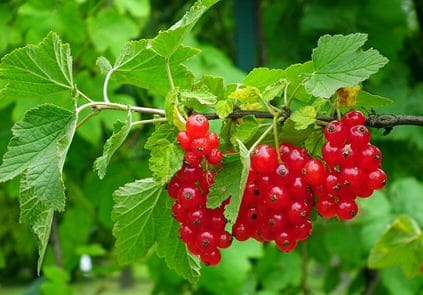
The red currants are a member of the genus Ribes in the gooseberry family. This shrub is easy to identify and commonly found in dark shady woodland, hedgerows and riverbanks, especially across the southern half of England.
These plants grow up to 1-1.5m in height and are upright in stature with a woody stem and leaves that are similar to a small maple leaf. Once you know what you are looking for they are easy to identify, but often confused with the black currant which has a larger leaf of about three times the size.
In late spring the plant produces dull and disappointing flowers of a yellow-green colour, but in early summer small clusters of up to twenty green berries form in each cluster. As the berries ripen and become a vibrant red they are ready for foraging, but just as with many berries, there is a small window of opportunity to enjoy them before the wildlife have had their fill.
Red currants are backed full of nutrients that aid circulatory health and energy. They can be enjoyed raw or added to many recipes including jams, tarts or sauces to accompany cooked meats.
Bilberry (Vaccinium myrtillus)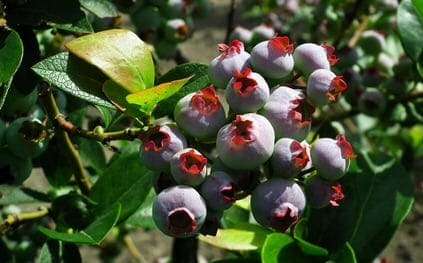
The Bilberry plant is found in woodland, moorlands and forests in temperate and subarctic areas of the Northern Hemisphere. This deciduous small shrub prefers acidic, well drained soil with partial shade.
The bilberry, also known as the whortleberry, huckleberry and European blueberry, is in fact part of the heather family and as well as producing the edible berries, bilberry has been used in herbal medicine for thousands of years.
So what is the difference between bilberries and blueberries? Traditionally blueberries were more of a cultivated type of berry, where as the bilberry was only ever found in the wild, though these days there are cultivated bilberries too. Blueberry flesh is light in colour whereas the bilberry flesh is a deep purple red. The bilberry plant is a low growing shrub so can be easily confused with blueberries, but both are edible so can both be enjoyed. Which is a bonus when collecting wild summer edibles!
Wild growing bilberries are packed full of nutrients and are partially beneficial for eye health. The berries can be enjoyed raw or added to recipes such as jams, sauces or pies.
Chickweed (Stellaria media)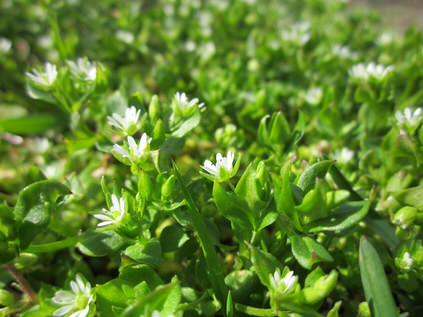
Chickweed is a perennial flowering plant that can be foraged for food or dried to be used as a cooling herb for herbal remedies. It grows in a variety of places from shady parks, grasslands, under trees and in the cracks of pavements too. If you look closely you’ll see that the plant has a single line of hairs down just one side of its stem making it slightly easier to identify.
Commonly deemed as a weed by gardeners, this foraged green has a fresh grass like flavour and no bitterness that is common in other foraged leaves. At this time of year look out for its small white star like flowers that can be eaten too. Both leaves and flowers can be added to salads, soups or pesto to give added nutrients to popular dishes.
When foraging pick the young lush leafy tops as these are the most tender, nutrient rich a delicious part of the plant. The older leaves can be a little tough and stringy. Similar to spinach these leaves are high in iron and can be eaten raw and cooked, though if eaten raw in abundance can lead to digestive discomfort. As with all foraging be sure to get your plant identification correct before you tuck in.
Elder Flowers & Berries (Sambucus nigra)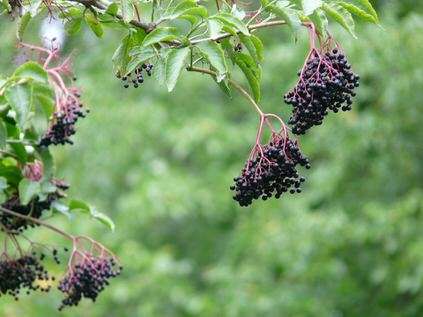
The Elder tree is steeped in history and folklore. Regarded as a protected tree because of the ‘Elder Mother’ residing in the trees trunk this was often grown next to gateways and entrances as it was regarded to keep away bad luck. For this reason the trees were rarely cut down or burnt.
Elders were also closely protected because of their medicinal benefits too. Not just the berries, but the flowers, the bark, roots and leaves have been used for centuries to treat a number of ailments and illnesses.
Often found in hedgerows and woodland, the Elder tree can reach heights of 10-12 metres. The trees are found to rarely live longer than 80 years and are characterised by their short trunk and greyish-brown farrowed bark.
From May, bunches of tiny white flowers hanging in sprays the size of saucers develop with a distinctive sweet smell. These flowers can be foraged and used to make classic summer drinks such as sweet elderflower cordial, elderflower champagne, sorbets or cakes.
If left, once pollinated, these small white flowers turn into a cluster of small purple-black berries. These sour berries are packed full of nutrients but should not be eaten raw as they induce vomiting and diarrhoea. However they are often taken in cooked supplement form to boost the immune system, reduce stress and support heart health.
Once cooked these berries can be made into jams, juices and pies and enjoyed with a glass of elderflower cordial, the taste of summertime.
Crab Apples (Malus sylvestris)
Found in hedgerows, gardens and woodlands these small ancestors of the cultivated apple tree can live up to 100 years old. These smaller trees favour moist soil and when exposed to the elements become twisted and gnarled with the twigs often developing spines. It is thought that this spined and crabbed appearance is one of the reasons that it has its name.
These smaller native trees are spherical and irregular in shape with a wide canopy. Though commonly a smaller tree, the Woodland Trust state that some have been found at 10 meters in height.
The small sweet smelling pink and white blossoms bloom from spring into summer, then once pollinated develop the tree’s fruit in late summer. Crab apples can be a variety of colours ranging from golden yellows, greens to russet reds when they are ready to harvest in late summer into early autumn.
Eaten raw these fruits can be incredibly bitter and can cause some digestive discomfort, but when cooked with sugar they make a great addition to summer puddings and to jams and jellies too.
Blackberries (Rubus fruticosus)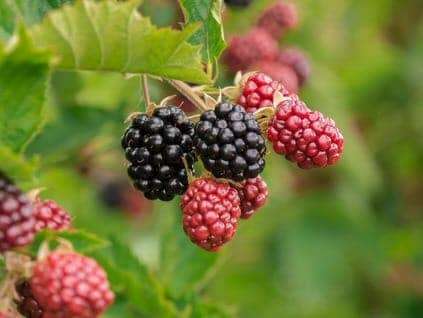
The bramble plant that produces the blackberries can grow just about anywhere. They make up dense hedgerows, cover scrubland, are found in woodland and are capable of growing pretty much anywhere in our climate.
As well as making the perfect habitat for a variety of wildlife these hardy prickly plants produce tasty and nutritious sweet berries from late summer into autumn.
The white blossoms that bloom from spring into summer develop into juicy edible berries from July to late August. They start as small hard green berries then as they ripen and grow in size they change from pink, to red and when fully ripen they are a deep purple-black colour and ready for harvesting.
These tasty, nutrient dense berries can be enjoyed raw straight from the plant, added to smoothies and salads or cooked into recipes such as pies, crumbles and hedgerow jams, or frozen to be enjoyed through the winter months.
So whether you are foraging greens to boost your summer salads and soups, harvesting berries to boost your health or picking fruit to freeze for comforting winter puddings, summer is the time of abundance.
Remember to forage your summer edibles responsibly and carefully insuring you have identified the plant correctly. Make sure you have the land owner’s permission, that you only take what you need and leave enough for others. But most importantly leave enough for the wildlife as they will be feeding young and themselves to make sure they are strong and healthy ready for the winter months. So get out there and enjoy your wild summer edibles!


